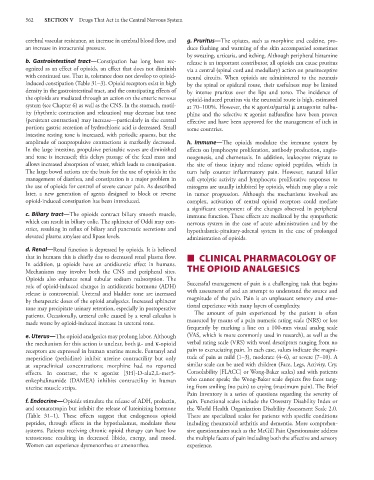Page 576 - Basic _ Clinical Pharmacology ( PDFDrive )
P. 576
562 SECTION V Drugs That Act in the Central Nervous System
cerebral vascular resistance, an increase in cerebral blood flow, and g. Pruritus—The opiates, such as morphine and codeine, pro-
an increase in intracranial pressure. duce flushing and warming of the skin accompanied sometimes
by sweating, urticaria, and itching. Although peripheral histamine
b. Gastrointestinal tract—Constipation has long been rec- release is an important contributor, all opioids can cause pruritus
ognized as an effect of opioids, an effect that does not diminish via a central (spinal cord and medullary) action on pruritoceptive
with continued use. That is, tolerance does not develop to opioid- neural circuits. When opioids are administered to the neuraxis
induced constipation (Table 31–3). Opioid receptors exist in high by the spinal or epidural route, their usefulness may be limited
density in the gastrointestinal tract, and the constipating effects of by intense pruritus over the lips and torso. The incidence of
the opioids are mediated through an action on the enteric nervous opioid-induced pruritus via the neuraxial route is high, estimated
system (see Chapter 6) as well as the CNS. In the stomach, motil- at 70–100%. However, the κ agonist/partial μ antagonist nalbu-
ity (rhythmic contraction and relaxation) may decrease but tone phine and the selective κ agonist nalfurafine have been proven
(persistent contraction) may increase—particularly in the central effective and have been approved for the management of itch in
portion; gastric secretion of hydrochloric acid is decreased. Small some countries.
intestine resting tone is increased, with periodic spasms, but the
amplitude of nonpropulsive contractions is markedly decreased. h. Immune—The opioids modulate the immune system by
In the large intestine, propulsive peristaltic waves are diminished effects on lymphocyte proliferation, antibody production, angio-
and tone is increased; this delays passage of the fecal mass and neogenesis, and chemotaxis. In addition, leukocytes migrate to
allows increased absorption of water, which leads to constipation. the site of tissue injury and release opioid peptides, which in
The large bowel actions are the basis for the use of opioids in the turn help counter inflammatory pain. However, natural killer
management of diarrhea, and constipation is a major problem in cell cytolytic activity and lymphocyte proliferative responses to
the use of opioids for control of severe cancer pain. As described mitogens are usually inhibited by opioids, which may play a role
later, a new generation of agents designed to block or reverse in tumor progression. Although the mechanisms involved are
opioid-induced constipation has been introduced. complex, activation of central opioid receptors could mediate
a significant component of the changes observed in peripheral
c. Biliary tract—The opioids contract biliary smooth muscle, immune function. These effects are mediated by the sympathetic
which can result in biliary colic. The sphincter of Oddi may con- nervous system in the case of acute administration and by the
strict, resulting in reflux of biliary and pancreatic secretions and hypothalamic-pituitary-adrenal system in the case of prolonged
elevated plasma amylase and lipase levels. administration of opioids.
d. Renal—Renal function is depressed by opioids. It is believed
that in humans this is chiefly due to decreased renal plasma flow. ■ CLINICAL PHARMACOLOGY OF
In addition, μ opioids have an antidiuretic effect in humans.
Mechanisms may involve both the CNS and peripheral sites. THE OPIOID ANALGESICS
Opioids also enhance renal tubular sodium reabsorption. The
role of opioid-induced changes in antidiuretic hormone (ADH) Successful management of pain is a challenging task that begins
release is controversial. Ureteral and bladder tone are increased with assessment of and an attempt to understand the source and
by therapeutic doses of the opioid analgesics. Increased sphincter magnitude of the pain. Pain is an unpleasant sensory and emo-
tone may precipitate urinary retention, especially in postoperative tional experience with many layers of complexity.
patients. Occasionally, ureteral colic caused by a renal calculus is The amount of pain experienced by the patient is often
made worse by opioid-induced increase in ureteral tone. measured by means of a pain numeric rating scale (NRS) or less
frequently by marking a line on a 100-mm visual analog scale
e. Uterus—The opioid analgesics may prolong labor. Although (VAS, which is more commonly used in research), as well as the
the mechanism for this action is unclear, both μ- and κ-opioid verbal rating scale (VRS) with word descriptors ranging from no
receptors are expressed in human uterine muscle. Fentanyl and pain to excruciating pain. In each case, values indicate the magni-
meperidine (pethidine) inhibit uterine contractility but only tude of pain as mild (1–3), moderate (4–6), or severe (7–10). A
at supraclinical concentrations; morphine had no reported similar scale can be used with children (Face, Legs, Activity, Cry,
effects. In contrast, the κ agonist [3H]-D-ala2,L-met5- Consolability [FLACC] or Wong-Baker scales) and with patients
enkephalinamide (DAMEA) inhibits contractility in human who cannot speak; the Wong-Baker scale depicts five faces rang-
uterine muscle strips. ing from smiling (no pain) to crying (maximum pain). The Brief
Pain Inventory is a series of questions regarding the severity of
f. Endocrine—Opioids stimulate the release of ADH, prolactin, pain. Functional scales include the Oswestry Disability Index or
and somatotropin but inhibit the release of luteinizing hormone the World Health Organization Disability Assessment Scale 2.0.
(Table 31–1). These effects suggest that endogenous opioid There are specialized scales for patients with specific conditions
peptides, through effects in the hypothalamus, modulate these including rheumatoid arthritis and dementia. More comprehen-
systems. Patients receiving chronic opioid therapy can have low sive questionnaires such as the McGill Pain Questionnaire address
testosterone resulting in decreased libido, energy, and mood. the multiple facets of pain including both the affective and sensory
Women can experience dysmenorrhea or amenorrhea. experience.

